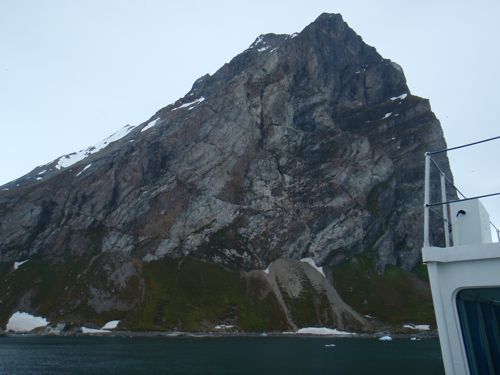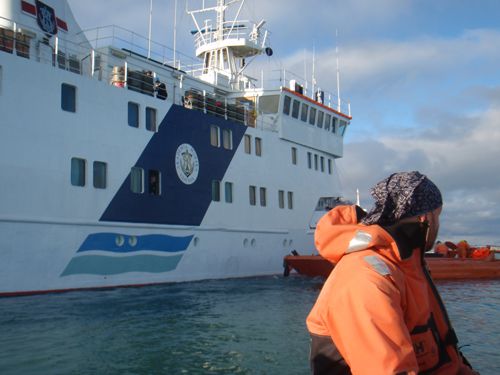Last day on the ship, if all goes well. R/V Horyzont II is a very nice ship, but we’ll all be glad to arrive at the station and start the scientific work we have prepared for over the last months. The waves and wind of the morning decrease as the morning progresses. Later during the day, we get close to Gnolloden, the “Humming Mountain”.

The trustworthy Atlas of Place Names in Svalbard attributes this name to the high number of birds and their constant noise. The small cape, not far from Hornsund, our final destination, is graced with a huge rock, 798 m high and extremely steep. Its cliff side is dotted with bird nests. The bottom beach has of course attracted scientists (ornithologists) studying the different colonies in this remote site … and polar bears, who roam at the bottom of the cliff, waiting for imprudent birds or those learning (and failing) to fly in late spring …
Small icebergs are on the south side of the fjord, ranging in colours from grey/white to nice, icy blue. The rain has come, sometimes thick, sometimes thin,. The hills and the big mountain nearby were covered in clouds when we arrived. A few hours later, the clouds moved up. And now they disappeared, leaving us with a perfectly grey sky and the promise of some sun (somewhere, behind the clouds).
A few hours later, the excitement builds up as we get closer to our final destination, in Hornsund (apparently named this way because 16th century explorers came back with a deer horn on their first time on land). With great help from the crew and other scientists, we transfer all the equipment to a new type of transfer vessel: an amphibian vehicle, looking very similar to the landing craft it might have been in a previous life but pained a bright orange, and used for peaceful purposes by the Hornsund people. And we get ready to transfer, in several small groups, on the usual rigid-hull inflatable boat (RHIB, or RIB, for short). No immersion suit, for this short transfer and because the sea conditions are extremely nice, but compulsory lifejackets.

The RIB beaches on the grey/black gravel a few hundred metres from the base, and after jumping out into the surf, we go and help out with the unloading of supplies. Some have been nicely packed on pellets, for example the food, drinks and miscellaneous material used by the station during its normal operation (the nearest shop is in Longyearbyen, and as we just experienced, it is a bit far away).Other stuff is loosely packed: I help carry an impressive quantity of onions and fresh products to the temporary storage area behind the kitchen.

The most important cargo is of course made of the different instruments we carried with us, on the ship, and earlier on in coaches (the National Express 3am service from Bath to Heathrow, for me), several flights … and customs … I had never thought before that small cylinders trailing several metres of cables could look suspicious through X-Rays … The security staff was rightly intrigued, and made a great audience when I started explaining what we would do with these hydrophones … Trust a scientist to be unstoppable when explaining his favourite subject ... (but they asked smart scientific questions :-))
Responses
I can just imagine you explaining your research going through customs - must have been like doing an Ignite talk - fast and furious!
Fast, yes, because they were very busy. Furious, no, because they soon proved to be very interested by the scientific aspect ... which shows everybody loves physics 🙂